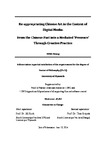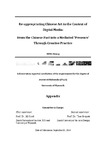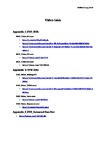Re-appropriating Chinese Art in the Context of Digital Media: From the Chinese Past into a Mediated ‘Presence’ through Creative Practice
| dc.contributor.supervisor | Scott, Jillian Margaret | |
| dc.contributor.author | HUNG , Keung David | |
| dc.contributor.other | Faculty of Arts, Humanities and Business | en_US |
| dc.date.accessioned | 2014-12-17T15:34:51Z | |
| dc.date.available | 2014-12-17T15:34:51Z | |
| dc.date.issued | 2014 | |
| dc.identifier | 10048264 | en_US |
| dc.identifier.uri | http://hdl.handle.net/10026.1/3182 | |
| dc.description | Full version unavailable due to 3rd party copyright restrictions. | |
| dc.description.abstract |
In this thesis, I argue that traditional Chinese thinking and its manner of approaching art can be successfully expanded onto a different platform: digital media art. My research (both in theory and practice) shows how this transformation expands the notions of time and space and forges new interdisciplinary correlations by addressing traditional Chinese culture in four different but interrelated manifestations: the philosophy of Dao, calligraphy, painting and sculpture. As a result, I claim that digital media can shift the notions of time and space from traditional Chinese thinking into contemporary digital art. Conversely, the digital concept of time and space can be interpreted by an analysis of (i) the traditional Chinese philosophy of Dao, so as to understand how ancient Chinese perceived the universe of time and space; (ii) four areas of Chinese art addressed in my theoretical and practical research (as elaborated in subsequent chapters). For example, a new understanding of ‘scroll format’, ‘play-appreciation’ and Chinese digital art has been introduced through my own practice. In fact, this direction has not been sufficiently dealt with in the past, and deserves more attention in the future. The thesis demonstrates how my practical research was heavily influenced and contextualized by my theoretical research, while the result of my practical artwork applies, expands and transforms that theory. This thesis aims, both theoretically and practically, at providing the reader with a new experience – the perception of the notions of time and space inherent in traditional Chinese thinking – by combining these concepts with digital technology. Many different methods used in traditional Chinese scroll painting and calligraphy have in their day investigated and developed new ideas of time and space – e.g. multiple perspectives, binary visual modes, visible and invisible spaces, reversed images and inverted vision. All of these concepts could be further extended through digital moving images and interactive art in order to provide the audience with a new spatiotemporal dimension as an enhancement of visual experience and knowledge. Through my experimental practice (i.e. interactive art, moving images, workshop and exhibitions), I have illustrated how digital art and digital technology can build on the notions of guan (觀; ‘to observe’), and you (遊; [1] ‘to tour’, ‘to travel’; or [2] ‘to roam’, ‘to saunter’). Furthermore, digital art can help viewers use the notions of play and appreciation – wan shang (玩賞, ‘play-appreciation’) – in Chinese context exhibition spaces. By exploiting this new dimension of experience, contemporary Chinese artists will, it is hoped, be able to introduce the spirit of traditional Chinese thinking to digital platforms, creating a guide that not only broadens the notions of time and space for digital media artists and audiences, but also forges new correlations between the various disciplines of philosophy and media art. This thesis, therefore, rests on three investigative pillars: (1) contextual analysis through the history of Chinese art and – to a lesser extent – Western art; (2) the possibilities of modern digital media art; (3) analysis and application of the Chinese philosophical tradition (art theory and the notion of time and space) to elucidate and develop the interface between traditional Chinese and modern digital art. The result of my research has shown that what emerges from – and also motivates – the investigation is an understanding that digital art (moving images and interactive art) is an appropriate and effective medium for the communication and deepening of Chinese cultural awareness. My research structure and development is divided into six steps as follows: Firstly, in developing this thesis, I posit that the ideas of time and space [Chinese terms and terminologies: shi jian (時間,‘time’), kong jian (空間, ‘space’), and yu zhou (宇宙, ‘the universe’)] have been handled in traditional Chinese scroll painting and calligraphy through the application of multiple perspectives, binary visual modes, visible and invisible space, the passing of time, and non-linear narratives. When these potentials are reproduced by media artists, novel insights, experiences and knowledge about time and space are re-interpreted for their audiences, while the history of time and space tends to collapse. Secondly, I examine the idea of the ‘Yellow Box’, whose original aim was to suggest a novel approach to the understanding of the relation between contemporary Chinese artworks and museum-based exhibition space. I argue, however, that such a direction does not consider the potential of digital media art, and my practical projects demonstrate that the ‘Yellow Box’ idea still has room for further development in its application to digital art history. Moreover, the analysis of time and space offered here in the context of my own media-art production process (custom software and hardware) can benefit other researchers and artists. The attempt to illustrate Chinese art theories and to document and reflect upon different ways of perceiving the position and role of the audience can provide a unique and fruitful insight into the incorporation of Chinese thinking and manners into media art practice. Thirdly, I analyse the correlation between traditional art and contemporary digital media art in relation to time. I first illustrate how multiple spatiotemporal experiences merge into one pictorial space in terms of non-linear narrative in some significant traditional Chinese art pieces, and then argue that digital art can actually help to re-interpret the traditional Chinese notion of time in a modern dimension. The results of my study reflect how the notions of (1) cycle, (2) non-linear narrative, and (3) ‘play-appreciation’ in ancient Chinese art correlate to the elements of ‘looping’ and ‘layering of content’ in digital art, which allow viewers to have real-time experience of ‘time passing and transitioning’. My analysis, however, also indicates that some contemporary Asian digital artworks (all relating to time transition) have not yet considered the viewer’s spatiotemporal experience in relation to such idea as ‘play-appreciation’ through viewers’ bodily engagement. Fourthly, I examine the spatial correlations between Chinese and media art, and argue that there are many correlations between the past and contemporary Chinese art in the ways in which viewers’ virtual and physical experiences have been applied. I analyse how the idea of ‘two different positions of the viewer’, through painting, reliefs and gunpowder in China, correlates with digital media art today. Such correlation allows the artist to play with the idea of ‘multiple identities’ through digital media (e.g. dual and multiple screens). The results of the analysis reveal a strong correlation between traditional art forms and modern digital media art that permits the artist and the viewer to manipulate the idea of ‘multiple identities’ through dual and multiple screens in both real and virtual spaces. Reflecting this, my practical project demonstrates how pictorial and virtual space function as part of one’s cultural identities through viewers’ bodily engagement. For example, in line with my experience of multiple-identities in relation to my own Indonesian-Chinese background on the one hand, and the ‘upstairs culture’ of Hong Kong on the other, I combined a series of fragmentary stills and moving images in the ‘Upstairs / Downstairs’ project (2004-2012) to demonstrate how digital technology can help visualize the notions of multiple viewpoints through multiple screens. From there I went on to ask whether my Asian cultural background could help transform traditional visual experiences onto a digital platform by integrating a sense of ambiguity and multiple identities. As neither the direction of such a topic nor the technical approach had been embarked upon before, I created the interactive installation Bloated City & Skinny Languages (BCSL) (2006-08) in order to invite viewers to experience multiple identities through dual screen visual representations and corresponding bodily engagement. Fifthly, I integrate temporal and spatial aspects by examining and questioning the possibility and limitations of combining the ideas of shu (calligraphy) and hua (painting) in 2D and 4D practices today in China and Hong Kong. I first take the idea of ‘landscape-characters’ suggested by Hong Kong artist Kan Tai Keung (1942- ) as a case study, to exemplify a significantly new approach to combining the relation between shu, hua and long scroll format through ink painting, and I then compare this with other scroll format orientated works such as Beijing Olympics opening; Cursive II; The Broken Window and The Science of Aliens. The comparison leads into an examination of how the idea of long scroll format can be transformed into a contemporary mode by means of digital technology, which in turn demonstrates the impact of scroll format on spatiotemporal experience via digital technology in terms of viewer role shifting. Finally, the argument of the thesis is summarized and rounded off in a further practical research project, the series Dao Gives Birth to One (exhibition and workshop). This provides a sense of illusory spatial and temporal experience, and suggests how a sense of ‘cycle’ could alter our conception of time and space. By including the holistic or cyclical nature (infinite space and endless time) of the philosophy of Dao, my creative practices and workshops demonstrate that digital technologies show potential in enhancing viewers’ physical engagement with and in their experience. The results of the present research contribute new knowledge while making a number of suggestions and recommendations for artists and curators in, for example, translating the traditional Chinese idea of ‘play-appreciation’ from visual (2D) to virtual (4D) experience. This research and the practical art projects associated with it will, therefore, effectively contribute to the making of a new digital art history. | en_US |
| dc.description.sponsorship | Hong Kong Polytechnic University | en_US |
| dc.language.iso | en | en_US |
| dc.publisher | Plymouth University | en_US |
| dc.subject | Digital media art, Chinese philosophy | en_US |
| dc.title | Re-appropriating Chinese Art in the Context of Digital Media: From the Chinese Past into a Mediated ‘Presence’ through Creative Practice | en_US |
| dc.type | Thesis | |
| plymouth.version | Edited version | en_US |
| dc.identifier.doi | http://dx.doi.org/10.24382/3240 |
Files in this item
This item appears in the following Collection(s)
-
01 Research Theses Main Collection
Research Theses Main




